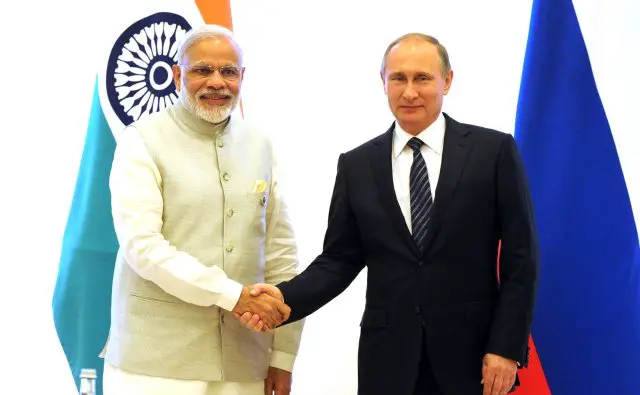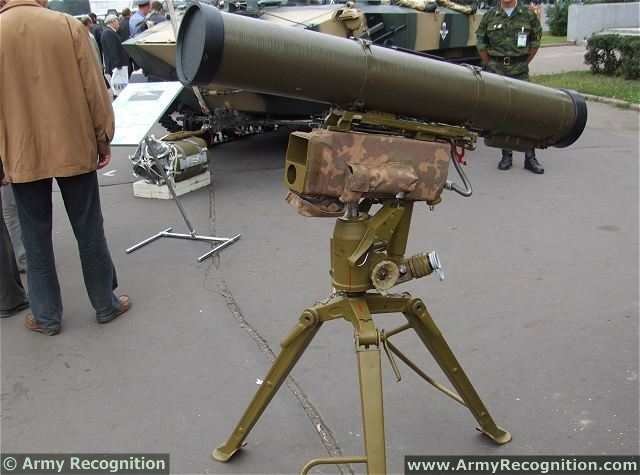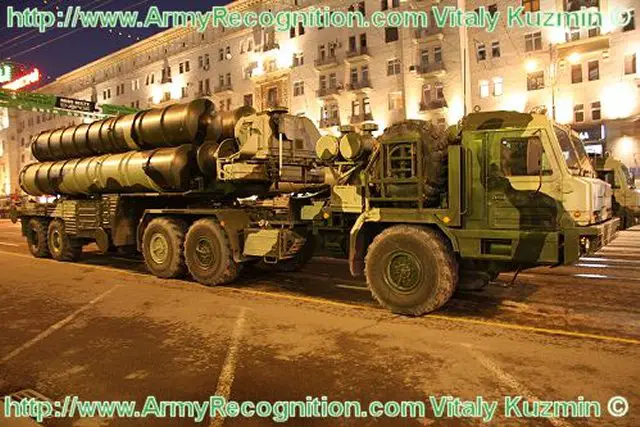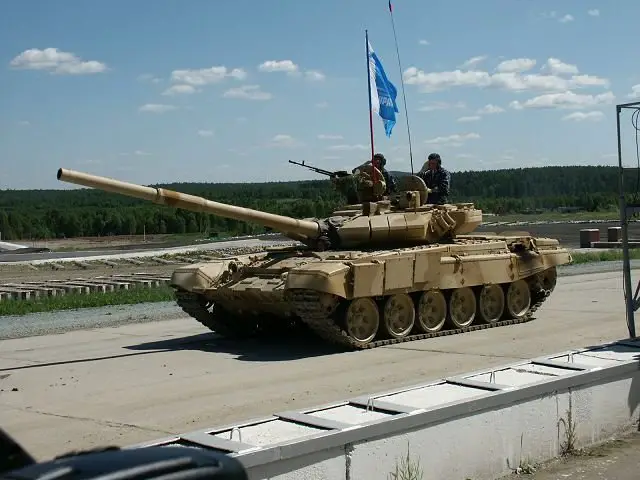|
|
|||
|
Defence & Security News - Russia & India
|
|||
|
|
|||
| Russia and India signed several agreements to enhance their military-technical cooperation | |||
|
The negotiations between the President of the Russian Federation, Vladimir Putin and India`s Prime Minister, Narendra Modi during the recent BRICS summit in Goa (India) have resulted in signing of several mutual military-technical cooperation (MTC) agreements, according to the Vedomosti newspaper.
|
|||
|
|
|||
 India's Prime Minister Narendra Modi and Russia's President Vladimir Putin India's Prime Minister Narendra Modi and Russia's President Vladimir Putin |
|||
|
|
|||
|
In particular, the countries signed an intergovernmental agreement that paves the way for the delivery of four batteries of S-400 Triupmh (NATO reporting name: SA-21 Growler) long-range air defense systems (ADS) to India. Previously, the People`s Republic of China (PRC) had become the launch customer for the systems, having ordered four S-400 batteries worth about USD2 billion. According to the editor-in-chief of the Moscow Defense Brief magazine, Mikhail Barabanov, India previously awarded Israel with a contract to develop the Barak 8 long-range surface-to-air missile (SAM) system. India`s decision to acquire S-400 may reflect several failures of Barak 8, the analyst supposes.
|
|||
|
|
|||
|
|
|||
|
Moscow and New Delhi also signed an intergovernmental agreement to deliver four Project 11356 (Admiral Grigorovich-class) frigates to India, Vedomosti reports. Previously, New Delhi received six surface combatants of such type named as Talwar-class in the Indian service. In 2011, Russia`s Ministry of Defense (MoD) ordered six Project 11356 frigates to be built by the Kaliningrad-based Yantar Shipyard (a subsidiary of the United Shipbuilding Corporation, Russian acronym: OSK) for the Russian Navy. The shipyard has already built three frigates for the domestic customer. Three remaining ships, however, faced a lack of gas turbine engines that were being supplied by the Zorya-Mashproekt company. Russia acquired the aforementioned powerplants, but the Ukrainian enterprise declined to deliver them. It was finally decided that New Delhi would receive the aforementioned gas turbine engines. One Project 11356 frigate for India is supposed to be built in Russia, while the hulls of the remaining ships will be delivered to India to be completed, the Vedomosti newspaper said citing a source close to the senior management of the Rosoboronexport arms exporting company (a subsidiary of the Rostec state corporation). Such scheme is in accordance with the 'Make in India' policy being implemented by the Indian government.
Rosoboronexport, the Russian Helicopters holding (a subsidiary of the Rostec state corporation), and Hindustan Aeronautics Limited (HAL) signed an agreement to establish a joint venture (JV) in India to produce Ka-226T Sergei (Hoodlum) light utility helicopters in India under license. The helicopters are intended for India`s Armed Forces and law enforcement agencies. The JV may assemble several hundred of Ka-226T helicopters, the Vedomosti newspaper supposes. According to a representative of Russia`s Ministry of Industry and Trade (Russian acronym: Minpromtorg), 60 rotor-wing aircraft are planned to be produced in Russia and the remaining 140 in India. Russia`s defense analysts suppose that the combined cost of the aforementioned agreements and the following contracts will exceed USD6 billion. According to IHS Jane`s, the financial values of the agreements for the S-400 ADS and for four Project 11356 frigates reached USD5 billion and USD4 billion, respectively. The cost of the JV for Ka-226T production reached USD1 billion, the analysts of the think tank suppose. "The two intergovernmental agreements, however, are not formal contracts. The latter are likely to be signed following negotiations over cost, delivery schedules, and offset obligations," the specialists of IHS Jane`s pointed out. India remains the biggest Russian partner in the area of military-technical cooperation. According to the Stockholm International Peace Research Institute (SIPRI), the combined cost of Russia`s defense deliveries to India reached USD3.834 billion in 2014-2015. India has ordered about 800 AL-31FP and 100 PS-90A turbofan engines produced by Russian United Engine Corporation (Russian acronym: ODK, a subsidiary of the Rostec state corporation), according to SIPRI. New Delhi signed the contract with Moscow for approximately 800 AL-31FP turbofan engines in 2012 and the related supplies started in 2013. The motors are intended for the modernization of Indian Su-30MKI (Flanker-H) multirole fighters. Russia supplies AL-31FP engines in kits, which are assembled in India under license. The deliveries are supposed to be finished by 2022. According to the open sources, the AL-31FP jet engine has an augmented rating of 12,500 kgf. India has also ordered about 100 new PS-90A turbofan engines for the modernization of 5 A-50EhI (Mainstay) airborne early warning and control (AEW&C) aircraft and 20 Il-76 (Candid) military-transport planes, the analysts of SIPRI say. Two contracts for supply of PS-90As were reportedly signed in 2012 (for eight engines) and in 2015 (for 92 engines) respectively. The relevant deliveries have yet to be started. The PS-90A turbofan engine was developed for the Ilyushin Il-76MD-90 military-transport aircraft and re-motorization of previously delivered Il-76 (Candid) transport planes of all types. PS-90A has a take-off thrust of 16,000 kgf. New Delhi is planning equip the newest Project-15A (Kolkata)/Project-15B (Visakhapatnam) destroyers and Project-28 (Kamorta) frigates with Russian 30mm AK-630 close-in weapon systems (CIWS), according to SIPRI. Moscow and New Delhi signed the first contract for 20 AK-630 CIWS systems in 2003 and the related deliveries started in 2014. The guns were intended for three Project-15A destroyers and eight Project-28 frigates being built by Indian companies. By end-2015, India had received eight AK-630 systems under the first contract. The second contract for 16 AK-630s was reportedly signed in 2013. The guns are supposed to be installed on four Project-15B destroyers. The deliveries under the second contract have yet to be started, SIPRI says. India is also producing Russian naval weapons and equipment under license. In 2003, Moscow and New Delhi signed the contract for licensed manufacturing of 14 RBU-6000 anti-submarine multiple launch rocket systems (ASW MLRS) for three Project-15A destroyers and four Project-28 frigates. The related deliveries started in 2014. As of end-2015, Indian Navy got eight RBU-6000 ASW MRLS systems. In 2000, India started the licensed production of Russian Garpun air search radars (designated Aparna in Indian service). Nine Garpuns were initially supposed to be manufactured. By end-2014, seven radars had been delivered. The Garpun radars are intended for three Project-15A destroyers, three Project-16A (Brahmaputra) frigates and three Project-17 (Shivalik) frigates. The radars will be integrated with Kh-35 (SS-N-25 Switchblade) anti-ship missiles (ASM). India received 68 Russian Mi-17V-5 (Hip-H) medium military-transport helicopters in 2014-2015, according to the Stockholm Institute. Moscow and New Delhi reportedly signed the contract for 68 Mi-17V-5 helicopters in 2013 and the related deliveries started in 2014. The agreement was valued at USD1.5 billion. According to SIPRI, 59 helicopters were intended for Indian Armed Forces and 9 for the national coast guard. The deliveries of all 68 aircraft had been finished by end-2015. The Stockholm Institute mentions India`s decision to acquire 48 more Mi-17V-5 helicopters. According to SIPRI, the rotor-wing aircraft were "selected but not yet ordered by end-2015". The potential agreement was valued at INR70 billion (USD1.1 billion). As of early 2016, Indian Armed Forces have received 188 Mi-8/17 medium military-transport helicopters (including 148 Mi-17V-5 and 40 Mi-17-1V rotor-wing aircraft) to the tune of USD2.9 billion, according to SIPRI. India`s border guard service has received six Mi-17 helicopters in basic configuration. |
|||
|
|
|||
 Russian 9M113 Konkurs anti-tank guided missiles (ATGM) |
|||
|
|
|||
|
New Delhi had taken the delivery of approximately 7,000 upgraded Russian 9M113 Konkurs (AT-5 Spandrel) anti-tank guided missiles (ATGM) by late 2015. Russia and India signed the contract to supply about 10,000 Konkurs anti-tank missiles to Indian Armed Forces in 2012. The agreement was valued at USD225 million. The deliveries of the ATGMs started in 2013. As of late 2015 India received about 7,000 missiles. The ending date of the 9M113 deliveries is not disclosed. Konkurs missiles are partially produced in India under Russian license. Indian Armed Forces have notified the country`s government on the shortage of anti-tank weapons for many times. Russian-originated reliable 9M113 Konkurs missiles will relieve the aforementioned problem. The Russian-Indian BrahMos Aerospace JV manufactured 450 PJ-10 BrahMos guided missiles of all types in 2006-2015, according to the Stockholm Institute. The first contract for 150 BrahMos anti-ship/surface-to-surface missiles (ASM/SSM) was signed in 1998 and the related deliveries started in 2006. By end-2015, Indian Armed Forces had received 90 PJ-10s under the agreement. In 1998, India signed the second contract for 400 BrahMos SSMs. Indian Armed Forces started to get the missiles under the second agreement in 2006. By end-2015, 350 PJ-10s in surface-to-surface configuration had been delivered. According to the Stockholm Institute, in 2012, India signed the contract for about 216 PJ-10 missiles in air-to-surface configuration. They were intended for Su-30MKI multirole fighters. As of end-2015, 10 such missiles were supplied. By end-2015, India had received 450 of 776 ordered PJ-10 BrahMos missiles. The HAL company produced 124 Su-30MKI multirole fighters under Russian license in 2006-2015, the analysts of SIPRI suppose. The first contract for the licensed manufacturing of 140 Su-30MKI fighters was signed in 2001. The aforementioned agreement was valued at USD3.5-4 billion. The deliveries started in 2005. As of end-2015, Indian Armed Forces received 124 Su-30MKI aircraft. India is supposed to get all 140 fighters by 2019. SIPRI pointed out, that the second contract for 42 Su-30MKI aircraft worth USD1.6 billion had been signed in 2012. According to the institute, the deliveries under the second agreement have yet to be started. New Delhi had upgraded 10 MiG-29 (Fulcrum) multi-role fighters to the MiG-29UPG (Russian designation: MiG-29SMT, Fulcrum-F) level by end-2015, according to SIPRI. The contract for modernization of 63 Indian MiG-29 fighters was signed in 2008 and the related works started in 2012. The deal was valued at USD850-965 million. As of end-2015, Indian Air Force received 10 MiG-29UPG aircraft. |
|||
|
|
|||
|
|
|||
|
As of late 2015, India produced about 290 T-90S (named in the Indian service as Bhishma) main battle tanks (MBT) under license provided by Russia. In 2006, Russia signed the contract with India for local licensed serial production of about 1000 T-90S MBTs for Indian Armed Forces, SIPRI says. The production of the tanks started in 2009. As of 2015, India manufactured about 290 MBTs, according to the institute. India is also running a licensed production of Russian 125mm 9M119 Invar anti-tank-guided missiles (ATGM) in accordance with the contract signed in 2013. The contract was valued at USD474 million. In total, about 25,000 ATGM are planned to be supplied (including 15,000 missiles supposed to be produced in India). SIPRI has not provided the actual data on Indian Invar production output. The Stockholm Institute also confirms (as of late 2015) the India`s intention to establish licensed production of 149 BMP-2 infantry fighting vehicles. The proposed deal was valued at USD141 million. Nevertheless, the relevant contract has yet to be signed, the analysts of SIPRI point out.
|
|||
|
|
|||
|
© Copyright 2016 TASS. All rights reserved. This material may not be published, broadcast, rewritten or redistributed.
|
|||

















